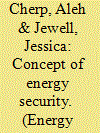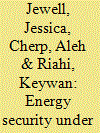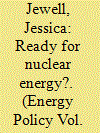|
|
|
Sort Order |
|
|
|
Items / Page
|
|
|
|
|
|
|
| Srl | Item |
| 1 |
ID:
136254


|
|
|
|
|
| Summary/Abstract |
Energy security studies have expanded from their classic beginnings following the 1970s oil crises to encompass various energy sectors and increasingly diverse issues. This viewpoint contributes to the re-examination of the meaning of energy security that has accompanied this expansion. Our starting point is that energy security is an instance of security in general and thus any concept of it should address three questions: “Security for whom?”, “Security for which values?” and “Security from what threats?” We examine an influential approach – the ‘four As of energy security’ (availability, accessibility, affordability, and acceptability) and related literature of energy security – to show it does not address these questions. We subsequently summarize recent insights which propose a different concept of energy security as ‘low vulnerability of vital energy systems’. This approach opens the road for detailed exploration of vulnerabilities as a combination of exposure to risks and resilience and of the links between vital energy systems and critical social functions. The examination of energy security framed by this concept involves several scientific disciplines and provides a useful platform for scholarly analysis and policy learning.
|
|
|
|
|
|
|
|
|
|
|
|
|
|
|
|
| 2 |
ID:
127304


|
|
|
|
|
| Publication |
2014.
|
| Summary/Abstract |
How would a low-carbon energy transformation affect energy security? This paper proposes a framework to evaluate energy security under long-term energy scenarios generated by integrated assessment models. Energy security is defined as low vulnerability of vital energy systems, delineated along geographic and sectoral boundaries. The proposed framework considers vulnerability as a combination of risks associated with inter-regional energy trade and resilience reflected in energy intensity and diversity of energy sources and technologies. We apply this framework to 43 scenarios generated by the MESSAGE model as part of the Global Energy Assessment, including one baseline scenario and 42 'low-carbon' scenarios where the global mean temperature increase is limited to 2°C over the pre-industrial level. By and large, low-carbon scenarios are associated with lower energy trade and higher diversity of energy options, especially in the transport sector. A few risks do emerge under low-carbon scenarios in the latter half of the century. They include potentially high trade in natural gas and hydrogen and low diversity of electricity sources. Trade is typically lower in scenarios which emphasize demand-side policies as well as non-tradable energy sources (nuclear and renewables) while diversity is higher in scenarios which limit the penetration of intermittent renewables.
|
|
|
|
|
|
|
|
|
|
|
|
|
|
|
|
| 3 |
ID:
166385


|
|
|
|
|
| Summary/Abstract |
The pursuit of civil nuclear power, frequently justified in the name of national energy security, paradoxically entangles most states in long-term interdependencies with the few countries that can supply nuclear technologies. These interdependencies are insufficiently documented and poorly understood. This article presents and analyzes a new dataset of nuclear cooperation agreements signed or announced between 2000 and 2015. We find that Russia and the US dominate international technological nuclear cooperation, with the US’ dominance particularly prominent in safety and security and Russia's in nuclear power plant construction, reactor and fuel supply, decommissioning and waste. When it comes to these technologies, Russia is the supplier in approximately half of all agreements; France, the US, China, Korea, and Japan together account for another 40%. All in all, six countries are suppliers in over 90% of all international nuclear agreements, a far higher supplier concentration than in oil and gas markets. These results show that the global future of nuclear power depends as much on international cooperation as on national motivations and capacities. Effective policies and institutions supporting the safe use of nuclear power should therefore be directed at managing its international as well as national aspects.
|
|
|
|
|
|
|
|
|
|
|
|
|
|
|
|
| 4 |
ID:
107524


|
|
|
|
|
| Publication |
2011.
|
| Summary/Abstract |
All of the North African countries have plans to develop nuclear power. If successful, nuclear energy could supply up to 9-15% of all electricity consumption in the region by 2030. How realistic are these plans and under what conditions can they be implemented? This paper seeks to answer this question by analyzing the motivations and capacities for deploying nuclear energy in the five North African countries by examining both regional and national factors. These factors are compared to similar characteristics of the countries with existing nuclear power programs using a series of quantitative indicators. While all five countries have strong motivations to develop nuclear power, which result from the high growth rates in demand for electricity and energy security concerns, their financial and institutional capacities to deploy nuclear energy vary and are generally lower than in those countries which already operate nuclear power plants. Most likely, North Africa will need to rely on external assistance to implement its nuclear energy plans. The article identifies three scenarios of nuclear power development from the interplay between internal and external factors, particularly the success of renewable energy projects and the ability to attract international investment in nuclear power.
|
|
|
|
|
|
|
|
|
|
|
|
|
|
|
|
| 5 |
ID:
103361


|
|
|
|
|
| Publication |
2011.
|
| Summary/Abstract |
The International Atomic Energy Agency reports that as of July 2009 there were 52 countries interested in building their first nuclear power plant. This paper characterizes and evaluates these "Newcomer Countries" in terms of their capacity and motivations to develop nuclear power. It quantifies factors historically associated with the development of nuclear energy programs and then benchmarks the Newcomers against these data. Countries with established nuclear power programs, particularly where nuclear facilities are privately owned, are typically larger, wealthier and politically stable economies with high government effectiveness. Nuclear power was historically launched during periods of high electricity consumption growth. Other indicators for the potential of nuclear power include: the size of the national grid, the presence of international grid connections and security of fuel supply for electricity production. We identify 10 Newcomers which most closely resemble the Established Nuclear Power Countries and thus are most likely to deploy nuclear energy, 10 countries where the development of nuclear energy is uncertain due to high political instability, 14 countries with lower capacities where pursuing nuclear energy may require especially strong international cooperation and 18 countries where the development of nuclear power is less likely due to their significantly lower capacities and motivations.
|
|
|
|
|
|
|
|
|
|
|
|
|
|
|
|
|
|
|
|
|